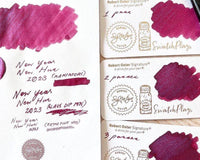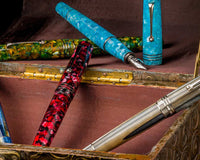As a fountain pen enthusiast, one of the more difficult choices you may have had to make is selecting the better pen: steel nibbed or gold nibbed. At first glance, the choice may seem obvious; gold is more valuable than steel, so surely, it will offer a better and more luxurious writing experience! Surprisingly, that is not always the case, and there is more to the steel vs. gold nib debate than meets the eye. Here, we’ll unpack the difference between these two nib materials to help you decide which is better for you.
Fountain pen nib materials
Fountain pen nibs are made of different materials, but the two used most often are gold and steel. Each has advantages and unique characteristics, making it an important factor to consider when choosing a fountain pen.
Nib material dictates how durable your pen will be and how long it will last.
The type of material your nib is made of will also determine how flexible and soft it will be when you write. Gold nibs are typically praised for being softer and more flexible, allowing for a smoother and more expressive writing experience.
Nib material will also affect the overall cost of your fountain pen. Since gold is a more precious metal, it tends to cost more than steel-nibbed fountain pens. Steel nibs are generally less expensive because of their accessibility.
Reasons to choose a steel nib

Most beginner fountain pen users start with a steel nib, and many enthusiasts who have been dabbling in the hobby for some time still use steel-nibbed pens. There are several reasons as to why steel nibs are still excellent for daily use.
Durability. Steel nibs are known for being quite hardy and are able to keep up with the demands of daily use. This makes them an excellent option for writers who want a reliable fountain pen that will last a long time.
Affordability. Steel nibs are generally more affordable than gold nibs, making them accessible to more writers.
Writing Feel. Steel nibs, unless they are made to flex, provide a much more rigid and firmer writing feel. This can benefit those who prefer more controlled writing with precise and consistent strokes.
Reasons to choose a gold nib

Gold nibs are highly sought after. Here are some reasons as to why you would want to consider having a gold-nibbed fountain pen (or two!) in your collection.
Softness. Gold is a softer metal than steel, which gives it more bounce and flexibility, depending on how the nib is created. Because they are more malleable, these nibs are widely considered to adjust to your handwriting style over time, providing a more unique and customized writing experience.
Karat Weight. You can get gold nibs in different karat weights, from 14k to 18k or higher. The higher the karat weight, the softer and more flexible the nib.
Prestige, Luxury, and Value. Gold nibs are created with great craftsmanship, often resulting in a fountain pen with high aesthetic value. These fountain pens are more than just writing instruments but luxury statement pieces that exude elegance and prestige. Collectors often buy fountain pens with gold nibs for this reason.
The role of tipping and alloys
History plays a significant role in the development of fountain pen nibs.
Back then, fountain pen inks were much more corrosive than today. While this was not an issue for dip pens, which could be cleaned and dried afterward to prevent rusting, it did become an issue for steel-nibbed fountain pens. Early fountain pens primarily used gold nibs since the metal didn’t corrode or rust. Gold is an incredibly stable metal and works with even the most highly corrosive iron gall inks without damaging the nib.
Let’s fast forward to the Second World War. Gold was needed for the war effort, so German pen manufacturers switched alloys instead. Montblanc, for instance, replaced their gold nibs with alloys made of gold, iridium, and palladium. Pelikan also jumped on board the alloy trend, replacing their golden nibs with ones made from palladium or chromium-nickel. Other German pen brands followed suit.

While these same pen manufacturers switched back to gold nibs after the war, the impact of alloyed nibs was significant. Today, many fountain pens (except for very inexpensive starter pens) are made of titanium and other modern alloys. You’ll also find that almost all modern fountain pen nibs, whether made of stainless steel, alloys, or gold, are tipped with iridium to prevent the nib's tip from wearing away with use. This means that no matter what metal your fountain pen nib is made of, the tip that touches the paper is made of the same material: iridium. If this is the case, then what is the point of having nibs made from different metals?
The secret is in the rest of the nib. While the tip is made of iridium, the tines of the nib that move (or don’t move) as you write will determine how different the writing experience is. Steel is often more rigid, while gold is slightly softer and bendier. It can be likened to a suspension on a car; gold nibs can give you a softer and more comfortable ride.
The real deal

There is so much more to nibs than simply being made of steel or gold. The writing experience is influenced by many factors, including how nibs are alloyed with other materials, the thickness of the metal, the shape of the nib, and more.
For instance, not all gold nibs will behave in the same way since they are all manufactured differently. There are gold nibs on the market that are just as rigid, if not more, than steel nibs. The “bounce” you get with a standard gold nib may not be present in another.
The smoothness you feel with your nib will also depend heavily on the tipping material and how well it is polished.
The bottom line
There are several differences between steel and gold nibs. However, determining the overall “winner” or better nib is not as simple as that. The characteristics of each nib make them suitable for various situations and different writers. Is a gold nib worth having? Absolutely — depending on what you want! Your best bet is to visit a fountain pen shop, attend a pen meet, or borrow your friend’s pens and experience both types of nibs. You can experiment with entry-level gold-nibbed fountain pens to feel how they differ from steel-nibbed pens; you can also try more luxury-level pens if that suits your taste.
The truth is there is no one-size-fits-all approach to choosing the right nib material, as there are pros and cons to each. It will depend on your preferences, writing style, and vision of how a pen should write. What’s important is choosing a pen with a writing performance you love.
Happy writing!
Written by EndlessPens Blogger Ramona Kabigting







